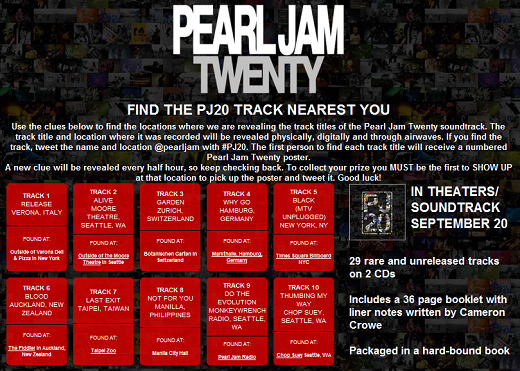
When I was a kid, I took part in a few scavenger hunts and the one thing that stays with me is the excitement when I actually found an answer to a clue. Now, as an adult (supposedly) the idea of scavenger hunts are still wildly appealing and let’s face it, some of us are simply never going to outgrow our childhood obsession with games.
Location based apps, twitter, and the Internet in general have turned scavenger hunts into a beast of a game, giving you the chance to play with people from all over the world, from the comfort of your home or city. Whether you’re running around with your GPS enabled phone, checking in to locations to get your next clue, or searching online for an answer to a cryptic question, the Internet has completely changed the face of the scavenger hunt, making it even cooler.
The most obvious example of online scavenger game come courtesy of Geocaching games like SCVNGR, where users check in at locations, and gain points by completing little tasks and challenges that are associated with that location. Points that you earn using SCVNGR are then translated into loyalty rewards, where you can get a discount, or a free item at a venue which is plugged into the SCVNGR system.
Beyond SCVNGR, location-based gaming has quickly evolved into an extremely successful marketing tool. Earlier this year, we introduced you to David Garrett’s location-based treasure hunt which had fans searching for physical items in the US and Germany, and this is just one of many examples of how the tool can be put to use.
A location based treasure hunt to promote tourism
Startup Wireless Stars, which is also the team behind IntaFeen, Egypt’s first check-in app, developed an entire platform making it easy to bring location-based services to your mobile device, GPS-enabled or otherwise. Using that technology, Wireless Stars has been branching off into various different avenues, one of which is the scavenger hunt.
Developing an app specifically for scavenger hunts, called Kinz Hunt (Kinz literally means treasure in Arabic), they have already organized 3 separate scavenger hunts in Cairo, and are busy preparing for a fourth in October.
We spoke to Dr. Maged Ghoneima, one of Wireless Stars’ cofounders, who told us a bit on where the idea came from.
“I’m obsessed with treasure hunts, I played it almost every year as a kid. So I thought, why don’t we take this concept and do multiple things with it? If I wanted to create a treasure hunt, I had to come up with clues, print them, hide them somewhere – and that would limit the number of participants and make it hard to administer. But what if I could put this in a mobile app? I already have a location platform, so I can do this really simply.”
The three scavenger hunts using Kinz Hunt have been varied in nature. One took place during a local conference, in which it encouraged conference visitors to check out booths they might not have noticed otherwise.
If I go to a symposium or a conference…People in the main aisle, pay a huge amount of money to be in the front aisle but there are many other booths at the back. We can drive people to them. Instead of putting out a banner, I’m going to force them to come to you by letting them play a treasure hunt. People were going from booth to booth, solving clues, figuring out which company they had to go to next, as well as interacting with the product.
Wireless Stars’ most recent attempt was a citywide scavenger hunt which was part of an educational experience focusing on entrepreneurship. Their upcoming scavenger hunt is also citywide, but is built on a very interesting premise – marketing tourism in Egypt. Following the January 25th uprising, Egypt’s tourism has suffered for countless reasons, and Wireless Stars want to do something to help.
Ghoneima told us of his plans for their Discover Egypt scavenger hunt:
“We want to tailor the treasure hunt so that it addresses the concerns that tourists have and addresses what Egypt has to offer. We thought, what if we designed a scavenger hunt in Cairo emphasising all the places you can go – monuments, landmarks, restaurants, scenic places. But we’re not going to do it just in Cairo – we’re going to do it in all the touristic cities. We’ve decided to do a Discover Egypt hunt series. This is an opportunity for tourists or residents who don’t want to take a conventional tour – they want to discover it in a different way which is fun and exciting.”
Participants will download the app to their phones, check-in at the first location to get their first clue, and then zip around the city, going after clues, and at the same time, getting a taste of all what Cairo has to offer.
There is also the chance to win one of the prizes on offer. Wireless Stars is using a tried and tested formula that has been met with success in the past.
Wireless Star’s scavenger hunt is a concept which is relatively new to Egypt, and the idea of tailor-made tours, combined with the gaming aspect of the hunt, could prove to be a much needed boost for Egypt’s tourism sector.
Gowalla and NASA create a museum-based scavenger hunt
Last year, Gowalla and NASA teamed up in a national scavenger hunt called ‘Search for the Moon Rocks.’
The NASA blog post detailing the event read:
NASA and Gowalla are bringing people one small step closer to the universe. Anyone who uses Gowalla, a mobile and web service, now has the opportunity to find and collect four NASA-related virtual items — a moon rock, a NASA patch, a spacesuit and a space shuttle.
Gowalla’s mission is to inspire discovery by connecting people with the places around them. When Gowalla users virtually “check-in” at NASA-related venues via their iPhone, Blackberry, Android, Palm or iPad, they now have a chance to find one of the four items.
By checking in at any of NASA Museum Alliance venue where moon rocks, brought back during the Apollo 12-17 missions, were on display, you could earn a special NASA related badge including a space suit and a NASA patch.
The first 100 Gowalla members to collect three out of the four NASA badges won a special NASA poster.
NASA and Gowalla’s efforts didn’t exactly send users running around looking for clues, but instead made it extremely easy to earn the badge, and if you were fast enough, win the poster. But what they managed to do was create buzz which brought more visitors into their museums. The scavenger hunt was a great example of how social media can be used for educational or cultural purposes, going beyond just checking in at your favourite restaurant.
Pearl Jam’s online scavenger hunt for songs
Last month, Pearl Jam conducted an online scavenger hunt to reveal the tracklist of Cameron Crowe’s upcoming documentary, “Pearl Jam Twenty.”
Fans were asked to use clues released on the Pearl Jam website and Twitter account to figure out locations where the track titles would be revealed. With clues revealed at physical locations, including Times Square and the Taipei Zoo but also virtual locations, including the Yahoo Answers and Craigslist (and even in a voicemail message), everyone had a chance to take part in the hunt, and win one of twenty Pearl Jam posters, by tweeting the track title accompanied by the hashtag #PJ20.
So how did the scavenger hunt itself do? Within 12 hours, Pearl Jam mentions on Twitter had quadrupled to 5.9 million tweets, and Pearl Jam’s website was Columbia’s most viewed page of the day. It’s not surprising that a band of Pearl Jam’s stature can draw that kind of a crowd. What’s really cool about it is the fact that Pearl Jam have been around since 1990, (yes that’s over 20 years), but the band certainly has its hand on the pulse of modern marketing tactics.
Why the scavenger model works
The scavenger model for marketing gives you instant user interaction. Who doesn’t love to win prizes?Combine that with the gaming aspect of treasure hunts and you’ve got instant buzz on your hands, with the potential to go viral.
For example, if you follow Pearl Jam’s idea, incorporating a Twitter hashtag into the game. The scavenger model’s elements of gaming and social media make it fun and exciting for people to participate, as was seen in NASA’s example, to create an educational experience.
Pearl Jam showed how you need very little resources to get the hunt off the ground – all you need is the Internet.
Wireless Star’s example shows you how you can tailor the experience to fit your audience, location and purpose.
There are various ways you can use the scavenger hunt model to create more buzz for your brand. Encourage players to work in teams, so you have instant word-of-mouth marketing. Offering both virtual and physical prizes can be a great incentive to get people interested in your hunt.
Scavenger hunts have the potential to include thousands of people, giving them the potential to go viral, and that is truly where their marketing strength lies since most of the hard work is done by the very same audience you’re trying to attract.
Have you seen any great examples of using scavenger hunts for marketing or educational purposes? Let us know about them in the comments.
Get the TNW newsletter
Get the most important tech news in your inbox each week.






